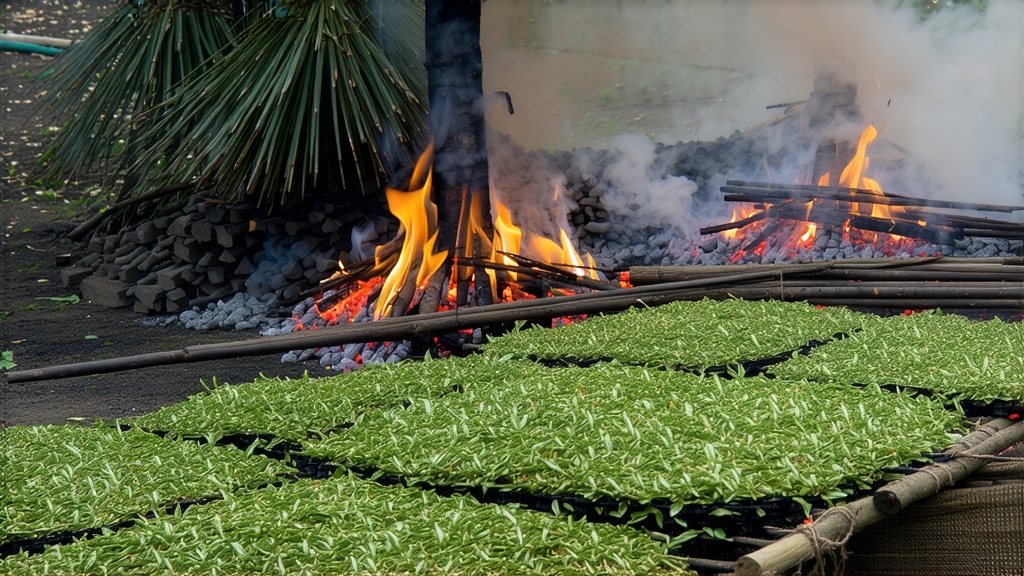
Long before English breakfast blends and Assam malts filled porcelain cups, a single tea left the granite gorges of northern Fujian and sailed halfway around the world to astonish European palates. That tea was Lapsang Souchong, the earliest documented black tea and the prototype from which every subsequent hong cha (“red tea” in Chinese) evolved. Today its name is often reduced to “smoky tea,” yet behind the fragrant veil of pine lies a layered story of military urgency, maritime commerce, and meticulous craft that deserves to be told in full.
Historical backdrop
The Wuyi Mountains, a UNESCO dual heritage site famed for vertical cliffs and winding Nine-Bend River, have grown tea since the Song dynasty. Local lore fixes Lapsang Souchong’s birth during the late Ming, around 1604, when marauding Qing troops forced farmers to speed-dry freshly picked leaves over open pinewood fires so the harvest would not spoil. The accidental smoke infusion created an entirely new aroma profile; the tea reached the port of Xingcun, then Macao, where Dutch traders bought the entire lot and shipped it to Amsterdam. Europe had never tasted anything so bold: a crimson liquor that could withstand months at sea and still deliver malt, resin, and a whisper of dried longan. Within decades “bohea” (the Min-bei pronunciation of Wuyi) became a luxury item in London coffeehouses, priced higher than green teas and immortalised in Pepys’ diary. The East India Company soon sent botanist Robert Fortune to steal both plants and know-how, laying the groundwork for Indian black teas, yet the original never lost its mystique.
Micro-terroirs and leaf grades
Authentic Lapsang Souchong hails from Tongmu Guan, a protected enclave inside the Wuyi National Nature Reserve where elevations climb above 1 200 m, humidity stays above 80 %, and diurnal swings coax slow, flavour-dense growth. Only six administrative villages may legally sell tea under the “Zheng Shan” (original mountain) designation. Outside this core, counties such as Guangze or Zhenghe produce “wai shan” versions that mimic the process but lack the mineral spring water and primordial forest air.
Chinese traders further subdivide the leaf:
- Zheng Shan Xiao Zhong – the unsmoked, honey-like “new style” requested by modern Asian markets.
- Traditional Song Zhong – the classic pine-smoke expression, using 300-year-old cultivars.
- Ji Pin (supreme grade) – one bud with two leaves, picked before Qingming, with downy tips that turn golden after smoking.
- Pekoe Souchong – slightly larger leaf, still aromatic but more affordable for daily drinking.
Craft: from withering to resinous fire
Making Lapsang Souchong is a race against enzymatic time. Picking starts at dawn when dew keeps the leaves pliable; by noon the bamboo baskets reach the smokehouse. There, long brick trenches called qinglong (“green dragons”) are filled with pinewood collected from Masson and Chinese red pines at least 30 years old—the high resin content is crucial. A gentle fire (never exceeding 80 °C) is maintained for 6–8 hours while layers of tea rest on bamboo screens 1.5 m above the embers. The smoke must be thick enough to scent the leaf yet cool enough to avoid cooking it. Masters judge readiness by aroma alone: a shift from fresh grass to grilled lychee and finally to deep pine forest signals the end of primary smoking.
Next comes rolling, brief 45-minute oxidation at 26 °C, and a second, shorter smoking called “lapsanging” that fixes the fragrance. The entire cycle spans 24 hours, after which the tea is rested in cedar-lined chests for at least 60 days so phenols integrate and harsh edges round off. When done correctly the finished leaf is glossy, strip-shaped, and smells like a campfire sweetened with caramelised dates.
Chemical signature
Gas chromatography reveals a trio of key volatiles: guaiacol, 4-methyl-guaiacol, and syringol—compounds also found in aged whisky barrels. These interact with the tea’s native linalool and geraniol to create what cuppers call “tarry rose.” Theaflavins remain moderate (8–10 % of